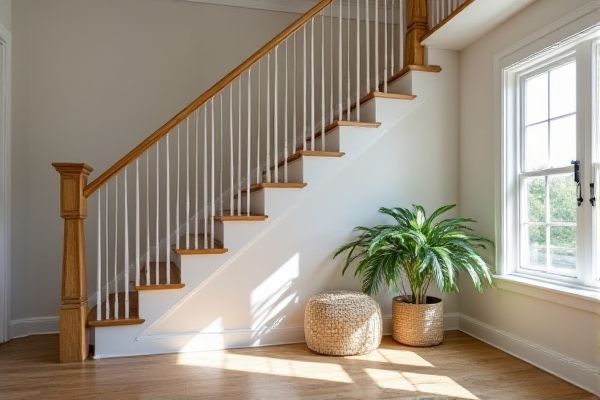
Classic spindle railing offers a traditional, timeless look with evenly spaced vertical balusters that provide sturdy safety and a defined architectural style, while cable rail features sleek horizontal cables that create an open, modern aesthetic with minimal visual obstruction and enhanced views. Explore the rest of the article to discover which railing option best suits your design preferences and functional needs.
Table of Comparison
| Feature | Classic Spindle Railing | Cable Rail |
|---|---|---|
| Material | Wood or Metal | Stainless Steel Cables |
| Design Style | Traditional, decorative | Modern, minimalist |
| Visibility | Partial, obstructs view | Almost unobstructed view |
| Maintenance | Periodic painting/staining | Low, occasional cable tightening |
| Durability | Moderate, susceptible to weather damage | High, corrosion resistant |
| Installation Complexity | Standard, straightforward | Requires precise tensioning tools |
| Cost | Affordable | Moderate to high |
| Safety | Sturdy, meets building codes | Meets building codes, requires proper tension |
Introduction to Classic Spindle and Cable Railings
Classic spindle railings feature vertical balusters typically made from wood or metal, offering traditional elegance and structural support. Cable railings utilize horizontal stainless steel cables stretched between posts, creating a modern, minimalist aesthetic with enhanced visibility and durability. Both options provide safety and style, but cable railings excel in open views and low maintenance, while classic spindle railings emphasize timeless craftsmanship.
Defining Classic Spindle Railings
Classic spindle railings feature evenly spaced vertical balusters, traditionally made from wood or metal, providing a timeless and sturdy barrier for decks or staircases. These railings emphasize craftsmanship and aesthetic detail, often with turned or carved elements that enhance architectural appeal. Your choice of classic spindle railings delivers a combination of safety and enduring style, distinct from the sleek, modern look of cable rail systems.
Understanding Modern Cable Rail Systems
Modern cable rail systems provide a sleek, minimalist alternative to classic spindle railings, featuring stainless steel cables that offer unobstructed views and enhanced durability against weather elements. Unlike traditional spindles, cable rails require less maintenance and create a contemporary aesthetic ideal for both indoor and outdoor applications. You can enjoy increased safety and a sense of openness without compromising style or strength in your railing choice.
Aesthetic Appeal: Traditional vs. Contemporary Styles
Classic spindle railing offers timeless elegance with its intricate, vertically aligned balusters, enhancing traditional architectural styles and creating a sense of warmth and sophistication. Cable rail provides a sleek, minimalist aesthetic, ideal for contemporary designs by maximizing views and allowing natural light to flow freely through open spaces. Choosing between the two depends on your preference for either the charming, ornate look of classic spindles or the modern, unobtrusive appeal of cable rail.
Durability and Maintenance Comparison
Classic spindle railing offers robust durability with its solid metal or wood construction, requiring occasional painting or staining to prevent weathering and maintain its appearance. Cable rail systems feature stainless steel cables that resist rust and corrosion, demanding minimal upkeep besides periodic tension adjustments and cleaning to retain clarity. Your choice depends on the balance between traditional sturdiness with moderate maintenance and the sleek, low-maintenance profile of cable rail.
Installation Complexity and Costs
Classic spindle railing typically involves straightforward installation with standard tools, making it a cost-effective option for most homeowners. Cable rail systems require specialized fittings and tensioning tools, increasing both complexity and labor costs. Your choice impacts overall budget, as cable rails often demand professional installation, elevating expenses compared to the simpler classic spindles.
Safety Considerations for Homes and Businesses
Classic spindle railings provide a traditional aesthetic with sturdy vertical balusters that meet safety codes by preventing small children or pets from slipping through. Cable rail systems offer sleek, modern designs using tensioned stainless-steel cables that meet or exceed building safety standards for strength and durability in both residential and commercial settings. Both options require proper installation and maintenance to ensure compliance with local safety regulations and to maximize protection against falls and accidents.
View and Openness: Transparency Differences
Classic spindle railing offers a traditional design with evenly spaced vertical balusters that create partial visibility while maintaining safety, resulting in a moderately open appearance. Cable railing utilizes horizontal stainless steel cables that provide maximum transparency and unobstructed views, enhancing the sense of openness in outdoor spaces like decks and balconies. The thin profiles of cable rails allow more natural light and scenery to pass through, making them ideal for locations where preserving panoramic views is a priority.
Environmental Impact and Material Choices
Classic spindle railings are typically made from wood or wrought iron, materials with moderate environmental footprints depending on sourcing and manufacturing processes. Cable rail systems often use stainless steel cables and aluminum or composite posts, offering enhanced durability and recyclability while requiring less maintenance, which reduces environmental waste over time. Choosing sustainably harvested wood for spindles or recycled metals for cables significantly lowers the ecological impact of either railing option.
Which Railing System is Right for You?
Classic spindle railing offers a traditional look with vertical balusters that provide strong structural support and enhanced safety, making it ideal for families or historic-style homes. Cable rail systems feature sleek, horizontal stainless steel cables that maximize visibility and create a modern, open feel, perfect for showcasing outdoor views or contemporary designs. Your choice depends on whether you prioritize a timeless aesthetic and privacy or a minimalist style and unobstructed sightlines.
 homyna.com
homyna.com